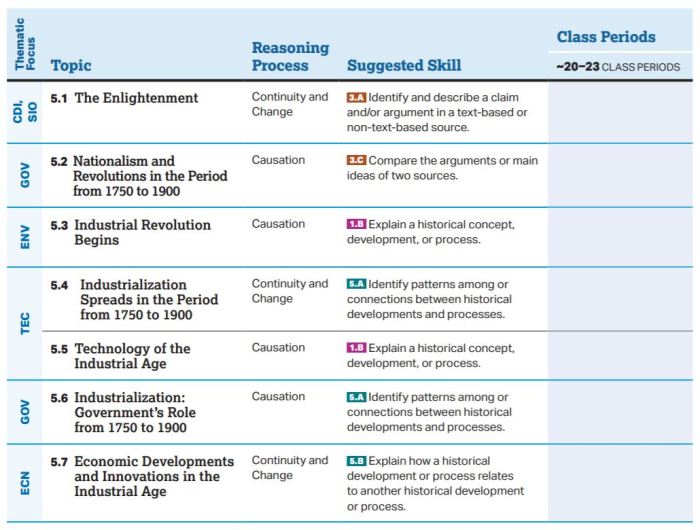Unit 5 changes and continuities in the industrial revolution – Unit 5: Changes and Continuities in the Industrial Revolution explores the transformative period that shaped the modern world. From technological innovations to economic and social upheavals, this unit delves into the profound impact of industrialization on societies and the legacies that continue to shape our present.
The Industrial Revolution brought about unprecedented technological advancements, transforming production processes and industries. It catalyzed the shift from agrarian to industrial economies, fostering the rise of capitalism and economic growth. However, it also brought about social and cultural changes, including urbanization, the changing roles of women and children, and the emergence of new social classes and labor movements.
1. Technological Innovations and Changes
The Industrial Revolution was marked by a series of major technological innovations that transformed production processes and industries. These innovations included:
Steam Engine
- Invented by James Watt, the steam engine provided a reliable and efficient source of power for factories and transportation.
- It replaced water power and animal power, enabling factories to operate independently of geographical constraints.
- Led to the development of steam-powered ships and locomotives, revolutionizing transportation and trade.
Textile Machinery, Unit 5 changes and continuities in the industrial revolution
- Inventions such as the spinning jenny, power loom, and cotton gin dramatically increased the efficiency of textile production.
- Reduced labor costs and made textiles more affordable, leading to a surge in demand.
- Created new industries and transformed the fashion industry.
Iron and Steel Production
- Advances in iron and steel production, such as the Bessemer process, enabled the mass production of iron and steel.
- These materials were essential for the construction of factories, railroads, and bridges, as well as for the production of machinery and tools.
- Led to the rise of heavy industry and the development of new engineering techniques.
Impact on the Workforce and Society
- Technological innovations displaced skilled artisans and created a demand for unskilled labor.
- Led to the rise of factories and the concentration of workers in urban areas.
- Increased productivity and economic growth, but also created social and economic inequality.
2. Economic Transformations
The Industrial Revolution brought about significant economic transformations, including:
Shift from Agrarian to Industrial Economies
- Pre-industrial societies were primarily agrarian, with the majority of the population engaged in agriculture.
- The Industrial Revolution shifted the focus from agriculture to industry, leading to a decline in the rural population.
- Industrialization increased productivity and created new economic opportunities.
Emergence of Capitalism
- Capitalism emerged as the dominant economic system, characterized by private ownership of capital and the profit motive.
- Entrepreneurs played a crucial role in driving economic growth by investing in new technologies and businesses.
- Capitalism fostered competition and innovation, but also led to economic inequality.
Increased Wealth and Economic Inequality
- The Industrial Revolution led to an increase in wealth and economic growth for some, particularly factory owners and entrepreneurs.
- However, it also created a gap between the wealthy elite and the working class, who often lived in poverty.
- Economic inequality became a major social issue, leading to labor movements and demands for social reforms.
3. Social and Cultural Changes

The Industrial Revolution had a profound impact on social and cultural life:
Urbanization and the Growth of Cities
- Industrialization led to the rapid growth of cities as workers flocked to factory centers.
- Urbanization created new social and cultural challenges, such as overcrowding, sanitation issues, and social inequality.
- Cities became centers of commerce, culture, and innovation.
Changing Roles of Women and Children
- In pre-industrial societies, women and children played significant roles in agriculture and domestic work.
- Industrialization drew women and children into the workforce, particularly in factories and textile mills.
- This led to changes in family structures and gender roles.
Rise of New Social Classes and Labor Movements
- The Industrial Revolution created new social classes, including the industrial working class and the capitalist elite.
- Workers organized into labor unions to fight for better working conditions and wages.
- Labor movements played a key role in shaping social and economic policies.
4. Continuities and Legacies: Unit 5 Changes And Continuities In The Industrial Revolution
Despite the transformative nature of the Industrial Revolution, there were also continuities with pre-industrial societies:
Continuities
- Social hierarchies and class divisions persisted, albeit in new forms.
- Religion remained an important aspect of social and cultural life.
- Traditional values and customs continued to influence people’s behavior and beliefs.
Legacies
- The Industrial Revolution laid the foundation for modern industrial societies and technological advancements.
- It shaped the way we work, live, and interact with the world around us.
- Both positive and negative legacies include increased productivity, economic growth, urbanization, environmental pollution, and social inequality.
FAQ Section
What were the major technological innovations of the Industrial Revolution?
Key innovations included the steam engine, power loom, cotton gin, and interchangeable parts, which revolutionized production processes and industries.
How did the Industrial Revolution impact the workforce?
Industrialization led to a shift from rural to urban labor, the rise of factories, and the emergence of new occupations and social classes.
What were the social and cultural consequences of the Industrial Revolution?
Urbanization, changing gender roles, the rise of labor movements, and the emergence of new social classes were significant social and cultural outcomes of industrialization.
